Delonghi EC702/EC710 Review. An Old Premium, Still Worth Buying.
Comments: 5↓ specifications & manual ↓
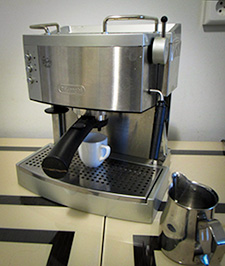
 Amazon.com Amazon.com
|
$184.94
14 new
from $180.93
6 used from $126.97
|
The Delonghi EC702 espresso machine (EC710 in Europe) is one of the last models from ’00s, which is still available on the market. It was a ‘pre-flagship’ model in Delonghi’s range and it’s still worth buying it – it’s better built if compared to modern models, however, have more usablity issues.
The construction and all the main parts – boiler, pump etc – didn’t change over the decade. From a technical point of view, the EC710 is a modern Delonghi ECO310, which was put in the wide full-metal body – see photos of the disassembled machine at the end. Some internals have even better quality. However (to start with the cons) there are some problems with ease of use:
If compared to any modern Delonghi espresso machine, the old EC702/710 has:
- Very low space under the portafilter – the maximum cup height you can use is only 67 mm/2.6″. With drip tray removed, which is huge by the way (500 ml/17 fl oz), you can get approx. 11 cm/4.4″, which is still not enough for high Irish glasses for latte macchiato.
- The panarello wand (exactly the same as installed on the ECO310/311) can move in only one plane and has a limited angle. However, since there is a lot of space around the steam wand, it’s no problem to use it. The problem is that the panarello is located just above the edge of the drip tray. Thus, all the milk drops will fall not into the drip tray, but on the body of the machine or on the table.
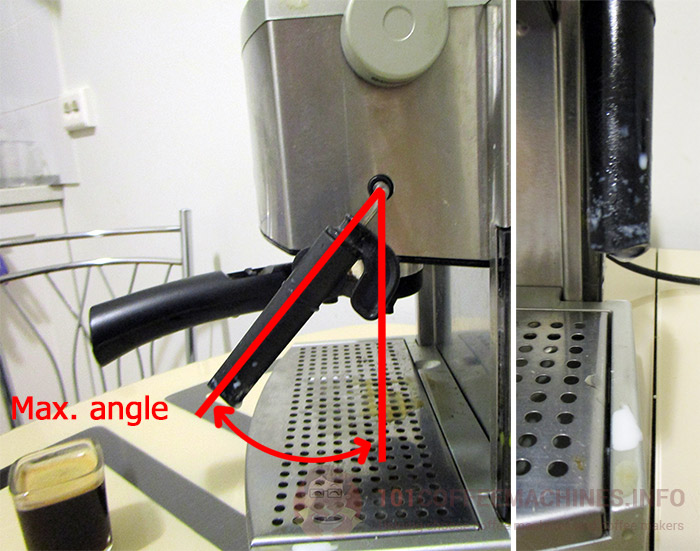
- It’s huge! The EC702/710 espresso machine alone takes more space than a compact modern machine and the grinder together. On the photo below you can compare EC710 and the hero of my previous review Krups Calvi:
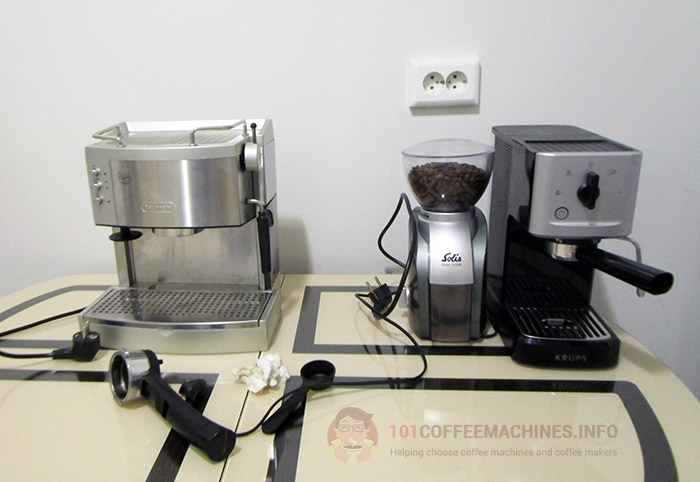
That’s probably all the negative facts about the Delonghi EC710 15-bar espresso maker. Perhaps only that in the nearest future, this machine will be discontinued and in 2-3 years it could become a problem to find spare parts. However, 90% of the internals are interchangeable with modern Delonghi models, so the only pieces I would worry about are unique parts like a water tank, for example.
The Pros. Or what is better in EC702 if compared to modern models
As I mentioned at the beginning of the review, the EC702/710 have the same internals as the ECO310 espresso machine. The only difference is a steam wand output, which is way more durable. The steam goes out of the boiler via solid copper made connector (like on Gaggia Viva), while all the modern Delonghi’s has plastic tubes. Just compare the following photo with photos in my 15-bar pump espresso machines test:
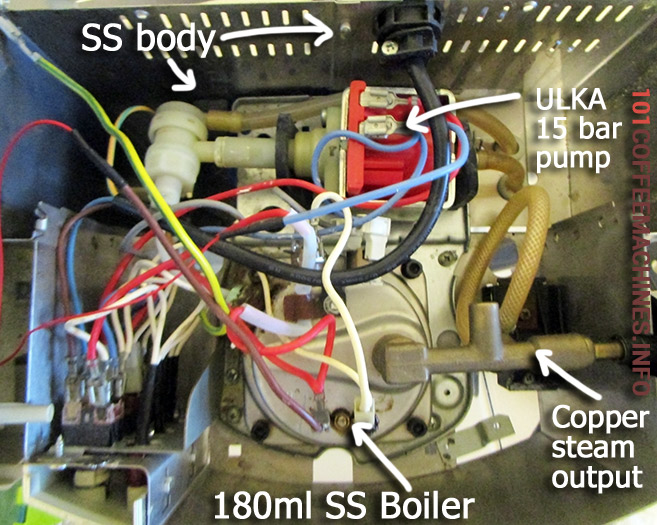
It also doesn’t have an auto shut-off function as modern models do.
But what is more important is a solid full-metal body. Why it’s better? Not only because it looks better. It really affects the taste of the coffee and the functionality:
- Full metal ‘jacket’ helps to evenly heat the group head, the boiler, and the filter basket. It may seem insignificant, but it really helps to extract more flavors out of the coffee. Make two sample espresso shot on the cold machine and after 5-10 minutes when the machine is heated well – you’ll see the difference.
- The passive cup warmer (the plate on top) works better. As on any budget espresso maker, the cup heater plater becomes warm simply by the heat of the boiler, which is located underneath. On the EC702 it is really hotter.
- There are fewer vibrations and fewer scratches on the cup stand. Any modern at-home espresso maker has a vibrating pump (here it is ULKA EP5 with a maximum pressure of 15 bar – the same is used on the majority of machines by Delonghi, Gaggia, Saeco, Breville, and others). On modern compact machines made of plastic, the vibration from the pump transfers to the body and cups make rattle noise and leave scratches on the cup stand. On this model, the well-isolated pump is located on top and the massive body has almost no vibrations. That also helps to keep the shiny metal outlook for longer.
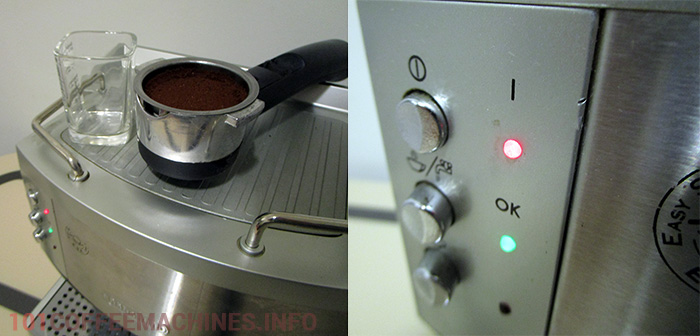
I will briefly repeat the key feautures that any boiler-based Delonghi espesso machine have in commons, the EC702/710 is not an exception:
- The 180ml stainless steel boiler. The biggest in the class of budget espresso makers. That helps to make bigger portions of coffee with the right temperature. Since Saeco and Gaggia (read here) switched to the aluminum boilers, the Delonghi is also the only brand that offers machines with Inox boilers under $500 budget.
- However, it’s still a boiler, not thermoblock like on the Delonghi Dedica or Delonghi La Specialista, so don’t expect it to be super quick. You’ll need to initially heat the machine for at least 3-5 minutes and wait longer for the steam. That’s the price you pay for the classical construction that can deliver better espresso in the hands of the experienced user.
- This machine is designed to brew classic Italian espresso. This means that with one load you can make up to 2-3 oz. After that, the temperature will fall and the extraction process spoiled. Thus, if you need to make a classic American coffee (caffe Americano) it’s better to dilute espresso with hot water (the machine has this function).
- It is equipped with pressurized filters (read below). They help you to get a decent cup of espresso with rich crema on any beans.
- You have to froth milk manually for your cappuccino, the frother isn’t automated like on the Mr. Coffee One-Touch CoffeeHouse, for example.
What else is different if compared to newer models by Delonghi?
- Delonghi EC702 – as well as the EC710, which is the same machine for the European market – uses filter baskets of ‘old’ type. Like on Delonghi EC155 (see my review) or ECO310. They have more plastic and requires more cleanings, however, they make better crema. The filters and holders are interchangeable, thus, you can always buy new baskets and use them in the EC-702.
- The integrated tamper is no good. It’s always the case, so it’s better to buy a separate one. You’ll need a 51mm tamper.
- The water reservoir is located on the left and has no access from the top. Its capacity is 1.3 L/44 fl oz by the way. You need to move it out of the machine to add the water. That means that you need at least extra 10-15 cm/4-6″ space on the left of the machine. Sum it up with the width of this espresso maker (29 cm) – you’ll need approx. 40-45 cm/16-18″ on your kitchen table to fit the EC702. On the other hand, it’s easy to see if there is enough water – the water tank has a yellow floater to indicate the current water level (see photo below).
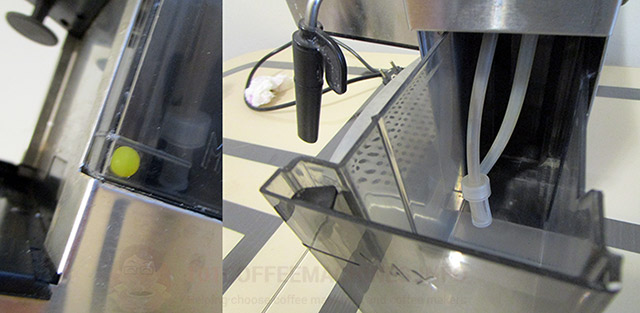
As you may notice there are two tubes in the reservoir. One sucks the water, while the other is an emergency tube that returns the water back in case the boiler is blocked for some reason (scale is the most common reason).
My Review Verdict
The EC702/710 espresso machine is an old model. But it doesn’t automatically make it outdated or less functional – there were no major improvements in Delonghi espresso maker’s construction for the last 10 years.
It has the same internals as modern boiler-based Delonghi models (ECP, ECO, ECZ, ECI series), but with better built-quality and the full metal body, which not only looks better but also helps to pull better shots. And by ‘metal body’ I mean real metal body – solid, heavy and thick steel. Not just a thin layer of aluminum alloy placed on the plastic frame like it is made on the Dedica for example:

The only cons of this model are usability issues: mainly huge dimensions and very limited cup height. It’s not very quick also, but it’s always the case if you choose among espresso machines with boilers, not thermoblocks.
I also think that this machine has a greater potential for upgrading and tuning it up than it’s modern counterparts sold for the similar price. It will make no sense to switch to unpressurized baskets in case of the Krups Calvi, for example. But the EC702 could be an affordable starting point for future experiments. Thanks to a classic design with large Inox boiler and metal body.
Overall, I can recommend it if you are ready to sacrifice usability issues to get a machine with a maximum of metal both inside and outside. And/or if you are a home-barista wanna who has a limited budget for your first set up. Another option to consider in that case is Delonghi America EC330 – also an old, well-built and affordable espresso maker by Delonghi:
I NEED your opinion. Please rate my review:
Delonghi EC702, EC710 Coffee Machine Specifications: |
|
|---|---|
| Download manual: | Download pdf manual |
| Machine type: | Pump espresso machine |
| Top rated: | 3rd in my list of best machines under $300 |
| Width х Deep х Height: | 28.5 x 23 x 32 cm (11.2 x 9 x 12.6 inches) |
| Coffee used: | Ground coffee or E. S. E. pods |
| Grinder: | No |
| Brewing group: | Pressurized metal filters of 'old' type |
| Heater: | Boiler 1100 W |
| Max pressure: | 15 bar |
| Water container: | 1.3 L / 44 fl oz |
| Cappuccinatore: | Panarello |
| Max cup height: | 67 mm / 2.6″ |
| Controlling: | 3 metal buttons |
| Colors: | Silver Metal |


 (7 votes, average: 4.71 out of 5)
(7 votes, average: 4.71 out of 5)

Good Afternoon
I would like your advice on purchasing a new espresso machine. I had a Delonghi espresso machine S07 41922 which just makes one shot at a time, does not have a grinder, and manually froths milk. Very simple. I am interested in moving up a step to something with a grinder. I primarily drink lattes, flat whites, and an occasional cappuccino.( a by pass for in-laws would be nice). I have the time for a semi automatic but not sure if I would could learn all the tweaking to perfect an espresso shot. Since my drinks are mainly milk based that part is important .
Any suggestions? Mid to upper price range. So many to choose from and after reading reviews of leaking, noisey, weak shots, low pressure I am overwhelmed of which one to choose.
Thanks for your thoughts. Angie A
Angie Anvar
27 Mar 19 at 5:34 pm
Hi Angie and sorry for my late reply.
Among semi-automatic machines I would recommend a set up of Gaggia Classic or Ascaso Dream (the most advanced machines, which are still equipped with pressurized filters, so you don’t have to “learn all the tweaking”, in the same time they can give you an opporunity to make experiments) + decent grinder (and it’s better to spend more on the grinder). Among popular brands you may look for Baratza, for the Classic it’s better to choose something upper that Baratza and Virtuoso.
If you want to turn to super-automatic machines, then there are thousands of models and you din’t mentioned what particular functions do you need. The most important defining criterion would be the type of the frother: manual (as you had on your machine), semi-automatic or automatic (see differences here http://101coffeemachines.info/saeco-vs-delonghi/#tubevscarafe ) or both: manual (for latte art at weekends) and automatic (for automatisation and speed on the weekday mornings). After that choice it would be much easier to recommend particular model.
I would be happy to help if you’ll give more details! 🙂
P. S. If you want semi-automatic + grinder combined in one body, then there is almost no good options in these niche (except Lelit Combi, probably, but it has other weak points). Better buy seprately or turn to super-automatic.
Dmitriy
5 Apr 19 at 3:19 pm
Hi Dmitriy,
I have a D.L. 710 useing it primarily only for espresso shots and would like to service it but can’t find out how to, nothing on YouTube or breakdown diagrams, I’ve bought the silicone lubricant ready to service it, also I ” think that this machine has a greater potential for upgrading and tuning it up than it’s modern counterparts” How can I tune it up please ?
Thanks for my go to impartial info provided by your site,
Regards,
Craig
Craig Ramos
1 Nov 19 at 8:49 am
Hello, Craig. And sorry for my late reply, hope it’s not too late.
You don’t have to lubricate anything on this machine, only super-automatic machines with movable brewing units require it.
You may upgrade to unpressurized baskets and/or naked portafilter and/or change a steam wand. For example, many Delonghis are upgraded with Rancilio Silvia’s professional steam wand, there are many videos on youtube about it.
Theoretically, you may install a PID and/or modify over-pressure valve to make it adjustable, however I never heard about such tuning of Delonghi machines, so there is no videos/articles which I can send you and which you may rely on (only your own experiments).
Dmitriy
8 Nov 19 at 10:45 am
Thank you Dimitri, ditto late reply.Will check out the basket upgrades, thanks again for the info.
Craig Ramos
28 Nov 19 at 9:40 am